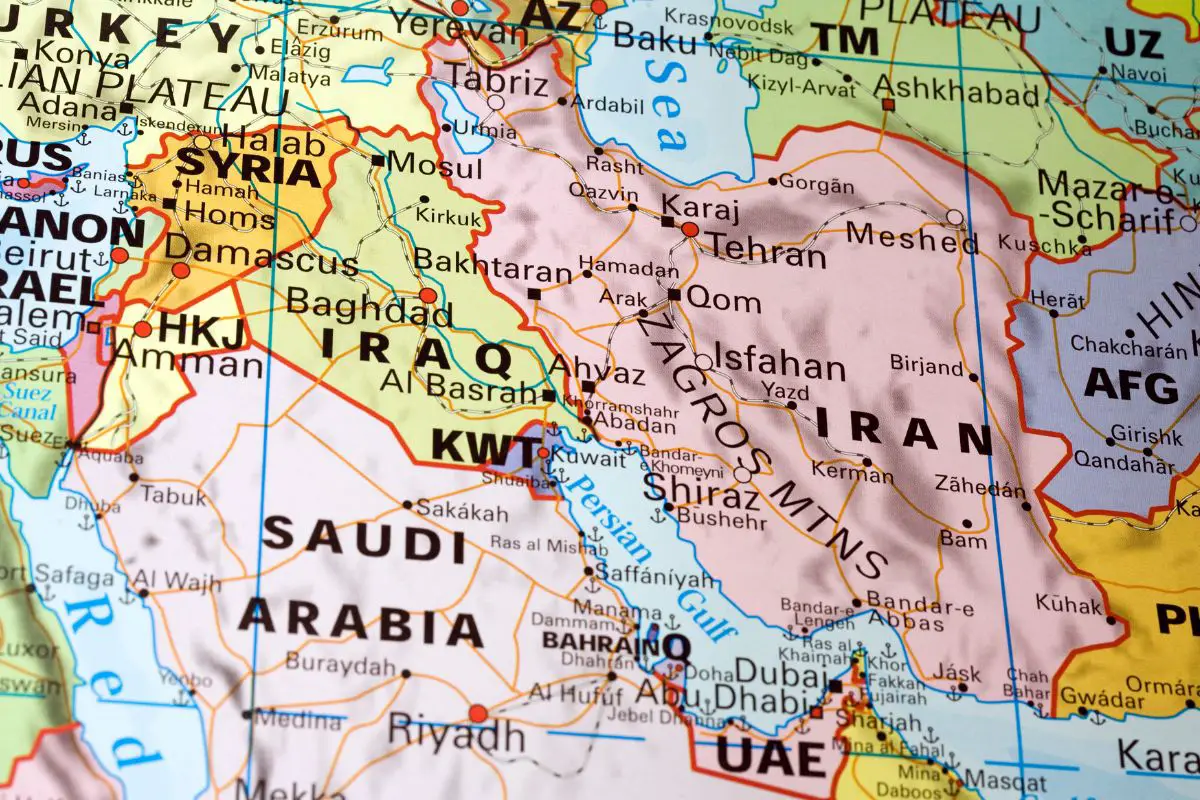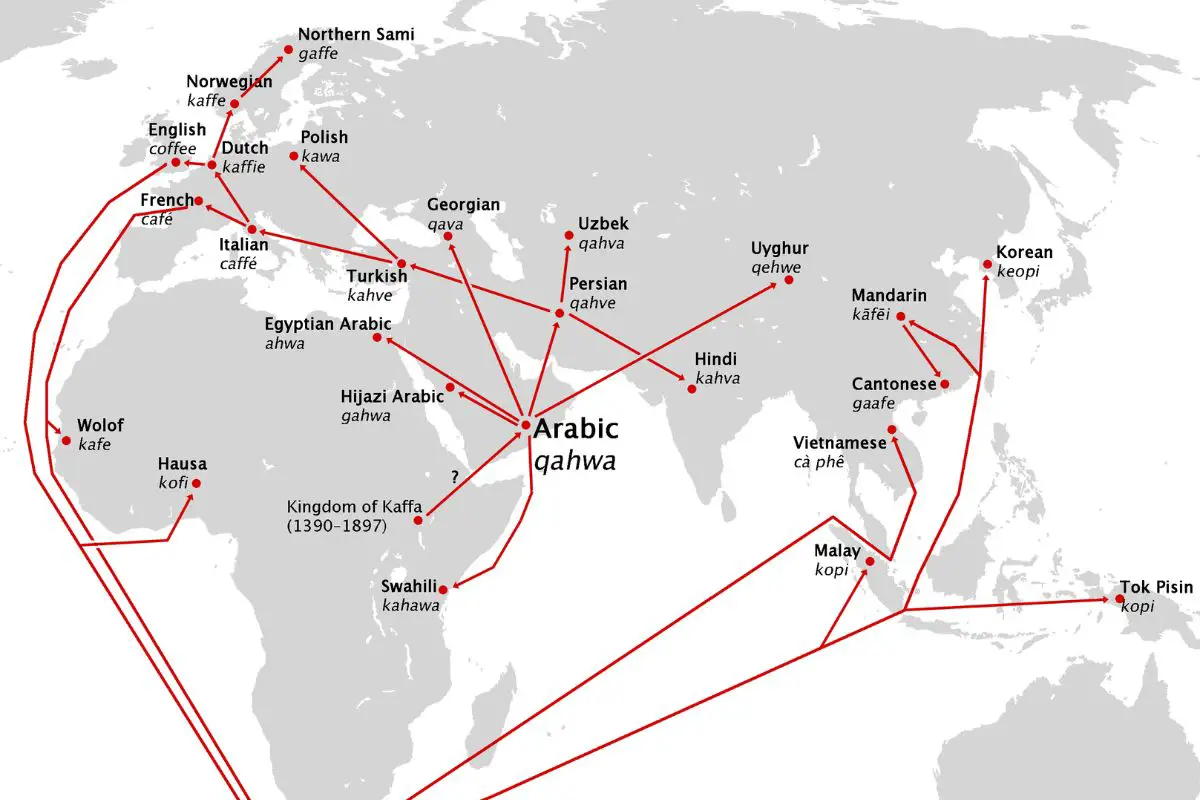In this article, the reader will explore the rich history of coffee and its trade routes in the Middle East. From its discovery in Ethiopia and early migration to other regions, to the role of Yemen and the Ottoman Empire; the article covers how coffee spread throughout the Middle East and the role of Sufis in the trade. Additionally, the reader will learn about the socio-political influences on coffee trade routes throughout history and the establishment of modern coffee trade routes in the region. Finally, the article discusses the impact of current political conflicts on future prospects for coffee trade in the Middle East.

Origins of Coffee and Early Trade
The discovery of coffee in Ethiopia
The history of coffee dates back to the 9th century, when it is believed to have been discovered in Ethiopia within the region of Kaffa. The legend of coffee’s origin involves a goat herder named Kaldi, who observed that his goats became unusually energetic after consuming the bright red berries of a certain tree. Intrigued, Kaldi decided to taste the berries himself and experienced the same energy-boosting effects. He shared his findings with a local abbot from a nearby monastery, who then experimented with the berries, eventually discovering how to brew the seeds into a stimulating beverage. Word of this invigorating drink quickly spread throughout the Ethiopian region and beyond.
Migration of coffee plants to other regions
The popularity of the coffee plant spread beyond Ethiopia as traders and explorers introduced the plant to other regions. In time, the cultivation and trade of coffee expanded to the Arabian Peninsula. The earliest known evidence of coffee cultivation dates back to the 14th century in Yemen. The beans were transported from Ethiopia to Yemen primarily through the port of Mocha, which would later give its name to the popular coffee variety.
It was in Arabia that the beans were first roasted and brewed, similar to the methods used today. The coffee beverage quickly gained widespread recognition and was widely consumed throughout the Arabian Empire, from the Persian Gulf to North Africa. As the demand for coffee increased, Arab traders established plantations in what is now Yemen, which became the primary exporter of coffee beans for centuries.
First documented evidence of coffee trade
The earliest documented evidence of coffee trade dates back to the 15th century when coffee beans were traded by merchants from the port of Mocha in Yemen. By the 16th century, the coffee trade had expanded to Persia, Egypt, Syria, and Turkey. The coffeehouses, known as Kaveh Kanes, became popular social hubs in Arab cities, where people gathered to enjoy the newly brewed beverage, share information, and conduct business.
The early coffee trade in Arabia was tightly controlled by the local governments, which forbade the export of fertile coffee seeds. This was done to maintain their monopoly on the lucrative coffee trade. However, in the late 17th century, the Dutch managed to obtain live coffee seedlings and successfully cultivate them in their colonies in Ceylon (now Sri Lanka) and Java (Indonesia). This marked the beginning of the global coffee trade as the Dutch introduced coffee to the European market.
Role of Yemen in the early coffee trade
Yemen played a critical role in the early coffee trade, as it was the first country to cultivate and export coffeebeans systematically. The port of Mocha emerged as the primary trading hub for coffee, from where the beans were exported to nearby regions such as the Arabian Peninsula and North Africa.
During the 16th and 17th centuries, Yemen held a monopoly over the coffee trade. The Sufi monks in Yemen, in particular, made significant contributions to coffee’s worldwide popularity by using the drink to stay alert during their nighttime prayers. Their stories of this energizing beverage caught the attention of travelers and traders, who then brought coffee beans back to their home countries.
The strict regulations imposed by Yemeni authorities on the export of fertile coffee seeds eventually led to the expansion of coffee cultivation in other regions such as Java and Ceylon. The Dutch, British, and French played crucial roles in introducing coffee plants to their colonial territories in Southeast Asia, the Caribbean, and South America, ending Yemen’s monopoly on the coffee trade and giving rise to coffee as a globally traded commodity.
The Spread of Coffee Throughout the Middle East
Introduction of coffee to the Ottoman Empire
The origin of coffee can be traced back to Ethiopia, where the coffee plant was first discovered around the 9th century. The stimulant properties of the coffee bean were soon recognized, making it a popular commodity in East Africa and the Arabian Peninsula. By the 16th century, coffee had made its way to the Ottoman Empire, an essential economic and cultural power in the Middle East during that time.
Coffee’s entrance to the Ottoman Empire is often associated with the arrival of Şükrüllah Yemeni, an Ottoman physician, who had been introduced to the drink during his travels to the city of Mocha, in modern-day Yemen. After returning to Istanbul, Şükrüllah prepared coffee for the sultan, who enjoyed it immensely. As a consequence, coffee began to spread throughout the region driven by the support of the Ottoman ruling elite.
Another important figure in the popularization of coffee in the Ottoman Empire was Ozdemir Pasha, the Ottoman governor of Yemen. He served the beverage to Sultan Suleiman the Magnificent at his court, presenting it as a luxurious, exotic drink, which increased its appeal among the upper classes of the empire. Coffee became a valuable commodity in the Ottoman Empire and was often gifted to visiting dignitaries.
Adoption of the coffeehouse culture
Coffee soon became an integral part of the Islamic culture as it established itself in the Middle East. With its origins in Ethiopia, the port city of Mocha (located in modern-day Yemen) had become the Middle East’s primary source of coffee. The bean’s strong and unique flavor, combined with its stimulating properties, made it an ideal beverage for the intellectual and social circles of the empire.
The first coffeehouse in the Ottoman Empire opened in Constantinople in 1554. These spaces, known as kahvehane, quickly became a significant part of the Ottoman society, catering to different social classes and functions. One could find coffeehouses dedicated to intellectuals, poets, politicians, and merchants, or to those simply seeking entertainment, such as chess, backgammon, or storytelling.
With the expansion of the Ottoman Empire into Europe and Asia, the coffeehouse culture began to spread as well. The coffeehouses of the empire became known as centers of social and political activity. Patrons would gather, often for hours at a time, to discuss the latest happenings, share stories, or enjoy music and other forms of entertainment.
Coffee trade routes among Arabian countries
As the demand for coffee grew in the Ottoman Empire, the bean’s cultivation expanded to several parts of the Middle East, primarily in Yemen. Mocha became the primary trading hub for coffee, establishing an essential trade route in the region. Coffee beans from Yemen, along with other valuable goods such as spices, spread throughout the Arabian Peninsula and reached the Ottoman Empire.
The Dutch East India Company and the British East India Company also played a significant role in trading coffee from the Arabian countries, widening its reach to Europe and further establishing its popularity among European consumers.
The success of the coffee trade also led to the erection of the Suez Canal in Egypt, which opened in 1869. The canal allowed for an expedited trade route between the Arabian Peninsula and Europe, significantly increasing the availability of coffee to consumers.
The spread of coffee throughout the Middle East drastically impacted the region’s cultural, social, and economic landscape. Its popularity gave rise to the prevalent coffeehouse culture and reshaped the way people interacted with one another. In addition, coffee soon became an essential trade commodity, establishing essential trade routes and impacting international commerce. Today, the Middle East remains one of the world’s largest coffee consumers and plays a significant role in the global coffee industry.
Role of Sufis in the Coffee Trade
Sufism, the mystical and spiritual dimension of Islam, played a significant role in the early history of coffee and its trade. The relationship between Sufis and coffee dates back to the 15th century, when the mystics discovered the stimulating properties of the beverage and incorporated it into their rituals and practices. This close association later led to the expansion of the coffee trade throughout the Middle East and beyond.
Influence of Sufism on the consumption of coffee
The early history of coffee is deeply intertwined with Sufism. In the late 15th century, Sufi mystics, particularly from Yemen, began consuming coffee to help them stay awake during their late-night prayers and meditation sessions. The stimulating effects of caffeine made coffee an ideal substitute for the traditional qat, an intoxicating leaf that was commonly consumed to achieve heightened spiritual experiences. However, unlike qat, coffee was not intoxicating, which made it a more suitable option with respect to Islamic teachings.
The Sufi practice of consuming coffee quickly gained popularity, and the beverages became an essential part of Sufi gatherings and religious ceremonies. As Sufism spread throughout the Middle East, the cultural and social acceptance of coffee grew along with it. Coffee houses began to emerge, creating an environment for people to engage in intellectual discussions, share knowledge, and become closer to the divine.
Coffee and religious ceremonies
The introduction of coffee profoundly affected the way Sufis conducted their ceremonies and rituals. Coffee became an integral part of Sufi gatherings known as Dhikr – a form of religious devotion involving the repetitive chanting of God’s names to seek spiritual purification and enlightenment. Consumption of coffee during these gatherings served two primary purposes: it allowed the worshippers to stay focused and alert, and it fostered a sense of communion between the participants.
Moreover, some Sufi sects believed that the physical act of drinking coffee had symbolic and sacred meaning. They viewed the dark, bitter beverage as a metaphor for spiritual purification and a means of transcending the earthly realm. As such, coffee was not merely a stimulant but a religious experience in itself.
The spread of Sufism and coffee throughout the Middle East

As the popularity of Sufism grew, so did the demand for coffee. The drink became an integral part of everyday life in the Middle East, creating new trade opportunities and economic growth. The port city of Mocha, in present-day Yemen, became an essential hub for the coffee trade, and the drink soon spread to other parts of the Arab world, such as Egypt, Persia, and the Ottoman Empire.
Coffee houses became an essential aspect of Middle Eastern society, functioning as social gathering spaces, political forums, and places of cultural exchange. The link between Sufism and coffee undoubtedly contributed to its rapid spread and acceptance throughout the region.
The growing demand for coffee in the Middle East eventually led to the expansion of the coffee trade to Europe, where the beverage found similar popularity. Over time, the religious significance of coffee in Sufi circles became less well-known as the drink became an essential part of global culture and trade.
In summary, the role of Sufis in the early history of the coffee trade is undeniable. Their spiritual practices and beliefs significantly influenced the consumption of coffee and contributed to its spread throughout the Middle East and beyond. The relationship between Sufism and coffee highlights the profound impact that religion can have on cultural practices and the shaping of global trade.
Socio-political Influence on Coffee Trade Routes

Socio-political issues have always had a significant impact on global trade, and coffee trade routes are not an exception. Many rivalries and power struggles have taken place to wrest control over the lucrative coffee trade. This article explores how socio-political factors played a role in shaping the coffee trade routes and industry.
Control of coffee production and trade by the Ottoman Empire
The Ottoman Empire controlled much of the coffee production and trade during the 16th and 17th centuries, which fundamentally shaped the coffee trade routes during that period. The first coffee houses were established in Istanbul, spreading throughout the empire and creating a coffee culture that became a significant aspect of Ottoman society.
Politically, the Ottoman Empire sought to maintain strict control over coffee cultivation, production, and trade. Coffee was a valuable commodity, and the empire wanted to ensure that they maintained a monopoly over its production and distribution, both to maintain their wealth and to form an economic foundation to fund their expanding empire. As a result, they banned the exportation of fertile coffee beans, limiting the ability of other nations to take advantage of the lucrative coffee trade.
However, despite the Ottoman authorities’ efforts, coffee eventually found its way to other regions. The Dutch, for example, managed to acquire fertile coffee beans from Yemen and began cultivating them in their colonies in the East Indies, most notably Java. This development would ultimately lead to the decline of the Ottoman Empire’s control over the global coffee market.
Rivalries between Arabian countries over coffee trade dominance
Coffee’s origin is in Ethiopia, but it was the Arab countries that first began cultivating and trading the beans, and they had a profound impact on the spreading of coffee around the world. The Arabian Peninsula, particularly Yemen, became the central hub of the coffee trade during the 15th and 16th centuries. The Port of Mocha in Yemen became synonymous with coffee and was a significant trading hub where ships from around the world came to purchase the prized beans.
Rivalries between regional powers in the Arabian Peninsula played a crucial role in the development of coffee trade routes. As different regions of the peninsula sought dominance over the burgeoning coffee trade, new trade routes emerged, and coffee spread further and further from its Arabian hub.
European influence on Middle Eastern coffee trade routes
Europeans first encountered coffee in the Middle East, and they were initially entranced by its rich, complex flavors and the social culture that had evolved around the drink. European traders soon established a presence in the region, both to profit from the lucrative coffee trade and to introduce the beverage to their home markets.
The involvement of European trading powers in the Middle Eastern coffee trade greatly affected both regional and global coffee trade routes. Venice became one of the first European cities to establish a coffee house in the 17th century, and the drink quickly spread across the continent.
In the following years, European colonial powers would seek to establish their coffee production to free themselves from dependence on the dominant producers in the Middle East. European powers like the British, Dutch, and French established coffee plantations in their colonies in Asia, the Americas, and Africa, which ultimately reshaped the global coffee trade routes and reduced the influence of the Middle Eastern producers.
To sum up, the socio-political factors have played an essential role in shaping the coffee trade routes globally. The control of the Ottoman Empire, rivalries between Arabian countries, and European involvement in the Middle East coffee trade led to the formation and transformation of trade routes that ultimately made coffee a global commodity.
Modern Coffee Trade Routes in the Middle East
Establishment of new trade routes in the post-Ottoman era
The Middle East has a long and rich history in the coffee trade, dating back to the Ottoman Empire. However, the collapse of the Ottoman Empire in the early 20th century led to the establishment of new trade routes in the region. These routes were formed to accommodate the changing political and economic landscape, as well as to cater to growing international demand for coffee.
During the post-Ottoman era, trade routes shifted from the traditional caravan trade to modern transportation methods such as railways, roads, and ships. This allowed more efficient and reliable transport of goods, including coffee beans. Furthermore, the establishment of national borders and subsequent political agreements facilitated the creation of new trade alliances in the region.
These new trade routes also enabled the Middle Eastern nations to diversify their trading partners, extending trade connections beyond the region and reaching markets in Europe, Asia, and the Americas. The Suez Canal, for instance, played a crucial role in connecting the coffee producers in the Middle East and Africa with European markets, significantly reducing shipping times and costs.
Current major coffee-producing countries in the region
In the contemporary Middle East, coffee production is concentrated in a few key countries. These are, primarily, Yemen and Ethiopia. Although there are some other coffee-producing countries in the region, such as Turkey and Iran, their production volume is considerably smaller in comparison.
Yemen has a long-standing tradition of coffee cultivation and remains one of the oldest coffee-producing countries in the world. Yemeni coffee is known for its distinct flavor, derived from its ancient cultivars and unique processing techniques. Yemen’s coffee export has faced challenges in recent years due to political unrest and conflicts, but efforts have been made to revive and sustain the coffee industry there.
Ethiopia, on the other hand, is the homeland of coffee and the largest producer in the region. The country boasts a diverse range of coffee varieties, with each region producing its distinct flavor profiles. Coffee is the backbone of the Ethiopian economy, providing livelihoods for millions of smallholder farmers, and the nation continues to focus on improving its coffee industry through the promotion of specialty coffee, investments in infrastructure, and research.
Impact of modern political conflicts on coffee trade routes
The Middle East has been a region marked by political tensions and conflicts in recent decades. These conflicts have had direct and indirect impacts on the region’s coffee trade, affecting production, transportation, and trade relations.
Security issues in Yemen have led to a severe decline in the accessibility of Yemeni coffee on international markets. The ongoing conflict has caused infrastructural damage and significantly hindered coffee production, thus restraining the potential of its coffee industry. Despite these challenges, however, Yemeni coffee remains highly sought after by coffee enthusiasts due to its unique flavor and rarity.
Moreover, geopolitical tensions have caused trade barriers and sanctions to be imposed on certain countries in the region. For instance, Iran, although not a significant coffee producer, has faced difficulties importing coffee due to sanctions. This limits the availability of quality coffee beans for local consumption, as well as constrains regional trade opportunities.
Future prospects for coffee trade in the Middle East

The Middle Eastern coffee trade has come a long way since the Ottoman times, adapting to the ever-changing geopolitical landscape. There are several positive prospects and potential for growth in the region’s coffee trade.
New trade agreements between countries in the region and beyond have the potential to create more opportunities for Middle Eastern coffee producers. The revival of coffee production in Yemen, for example, will depend largely on political stability and international partnerships dedicated to the development of the coffee industry.
Furthermore, the global demand for specialty coffee has been on a steady rise, creating a niche market that Middle Eastern coffee producers can tap into. Emphasis on improving coffee quality, sustainability, and differentiation through geographical indications can boost the region’s coffee trade and put them in a better position in the global coffee market.
In conclusion, while the Middle Eastern coffee trade faces challenges posed by regional instability and political conflicts, opportunities for growth and development, such as tapping into the specialty coffee market and forming strategic trade partnerships, could give the region’s coffee industry a positive outlook in the years to come.
FAQs on The Establishment of Coffee Trade Routes throughout the Middle East
1. When did coffee trading begin in the Middle East?
Coffee trading in the Middle East dates back to the 15th century, with the first known coffee trade starting in Yemen, where the beans were transported from Ethiopia (Hattox, 1985).
2. How did coffee trade routes expand throughout the region?
The coffee trade expanded through the region via Sufi monasteries, which distributed it across Yemen, Persia, and the Ottoman Empire. This eventually led to the establishment of the famous Silk Road coffee route in the early 16th century (Pendergrast, 1999).
3. What role did the Arabian Peninsula play in the coffee trade?
The Arabian Peninsula, particularly Yemen, played a crucial role in the coffee trade as the sole producer and exporter during the early stages of the industry. The port city of Mocha in Yemen became synonymous with coffee (Hattox, 1985).
4. How did the Ottoman Empire contribute to the growth of the coffee trade?
The Ottoman Empire contributed to the growth of the coffee trade by promoting the consumption of the beverage throughout its vast territories. Coffee quickly gained popularity in Constantinople (now Istanbul) and inspired the establishment of the first coffeehouses (Pendergrast, 1999).
5. What barriers did coffee traders face in the Middle East?
Coffee traders in the Middle East faced challenges such as harsh desert landscapes, lack of water, and piracy. Political upheavals and the occasional bans imposed by authorities in some areas also posed threats to the trade (Hattox, 1985).
Related Article:
The Ancient Trade Routes Connecting Yemen to the Rest of the World